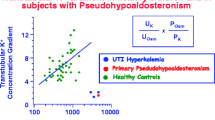Abstract
The aim of this study was to determine whether renal unresponsiveness to aldosterone associated with hyperkalemia is present in infants with acute pyelonephritis in the absence of significant urinary tract anomalies and to describe the clinical characteristics of patients presenting an inadequate renal response to hyperkalemia. The patient cohort comprised 113 infants with acute pyelonephritis (APN), based on the criteria of a temperature >38°C and significant bacteriuria. Serum and urine electrolytes, creatinine, osmolality, and renal tubular function tests were performed at diagnosis. The findings were compared to those present in 75 children who had fever without significant bacteriuria. Hyperkalemia (>5.5 mmol/L) was observed in infants with an APN diagnosis, who exhibited a lower transtubular potassium concentration gradient (TTKG) and a higher fractional sodium excretion. We defined inadequate renal response to hyperkalemia as the combination of hyperkalemia and TTKG below the normal range established for the age of the subject. Infants presenting an inadequate response to hyperkalemia were younger and associated more frequently with an APN diagnosis. This alteration could be explained by the renal interstitial inflammation present in acute pyelonephritis and the immaturity of the renal tubular responsiveness to aldosterone due to infancy in the absence of urinary tract infection or obstruction.
Similar content being viewed by others
References
Rodríguez-Soriano J, Vallo A, Oliveros R, Castillo G (1983) Transient pseudohypoaldosteronism secondary to obstructive uropathy in infancy. J Pediatr 103:375–380
Rodríguez-Soriano J, Vallo A, Quintela MJ, Oliveros R, Ubetagoyena M (1992) Normokalaemic pseudohypoaldosteronism is present in children with acute pyelonephritis. Acta Paediatr 81:402–406
Watanabe T (2004) Hyponatremia and hyperkalemia in infants with acute pyelonephritis. Pediatr Nephrol 19:361–362
Dolezel Z (2004) Secondary pseudohypoaldosteronism in an infant with pyelonephritis. Bratisl Lek Listy 105:435–437
Gerigk M, Glanzmann R, Rascher W, Gnehm HE (1995) Hyponatremia and hyperkalemia in acute pyelonephritis without urinary tract anomalies. Eur J Pediatr 154:582–584
Kenichi M, Watanabe H, Onigata K (2002) Reversible secondary pseudohypoaldosteronism due to pyelonephritis. Pediatr Nephrol 17:1069–1070
Nandagopal R, Vaidyanathan P, Kaplowitz P (2009) Transient pseudohypoaldosteronism due to urinary tract infection in infancy: a report of 4 cases. Int J Pediatr Endocrinol. doi:10.1155/2009/195728
Asano T, Abe M, Asai M, Imai T, Kamisago M, Kuwabara K, Nakajima M, Murakami M, Fujino O (2006) Urinary Tract Malformation and Infection with hyperkalemia and decreased fractional excretion of potassium in an Infant. J Nippon Med Sch 73:289–291
Sperl W, Guggenbichler JP, Warter T (1988) Changes in electrolyte and acid-base equilibrium in children with acute urinary tract infections. Padiatr Padol 23:121–128
Thies KC, Boos K, Müller-Delle K, Ohrdorf W, Beushausen T, Townsend P (2000) Ventricular Flutter in a neonate-severe electrolyte imbalance caused by urinary tract infection in the presence of urinary tract malformation. J Emerg Med 18:47–50
Szalecki M, Wójcik E, Domagala Z, Malunowicz E (2007) Pseudohypoaldosteronism in infants with salt wasting syndrome. Two case reports. Pediatr Endocrinol Diabetes Metab 13:33–36
Giapros VI, Tsatsoulis AA, Drougia EA, Kollios KD, Siomou EC, Andronikou SK (2003) Rare causes of acute hyperkalemia in the 1st week of life. Pediatr Nephrol 19:1046–1049
Bogdanovic R, Stajic N, Putnik J, Paripovic A (2009) Transient type 1 pseudo-hypoaldosteronism: report on an eight-patient series and literature review. Pediatr Nephrol 24:2167–2175
Watanabe T (2003) Reversible secondary pseudohypoaldosteronism. Pediatr Nephrol 18:486
Rodríguez Soriano J (2002) Renal tubular acidosis: the clinical entity. J Am Soc Nephrol 13:2160–2170
Weber KT (2001) Aldosterone in congestive heart failure. N Engl J Med 345:1689–1697
Valenstein P, Meier F (1998) Urine culture contamination. Arch Pathol Lab Med 122:123–129
Yiee J, Wilcox D (2007) Management of fetal hydronephrosis. Pediatr Nephrol 23:347–353
Fefer S, Ellsworth P (2006) Prenatal hydronephrosis. Pediatr Clin North Am 53:429–447
Gargollo PC, Diamond DA (2007) Therapy Insight: what nephrologists need to know about primary vesicoureteral reflux. Nat Clin Pract Nephrol 3:551–556
Rodríguez Soriano J, Vallo A (1990) Transtubular potassium concentration gradient: a useful test to estimate renal aldosterone bio-activity in infants and children. Pediatr Nephrol 4:105–110
Choi MJ, Ziyadeh F (2008) The utility of the transtubular potassium gradient in the evaluation of hyperkalemia. J Am Soc Nephrol 19:424–426
Karet FE (2009) Mechanisms in hyperkalemic renal tubular acidosis. J Am Soc Nephrol 20:251–254
Geller DS, Rodríguez-Soriano J, Vallo Boado A, Schifter S, Bayer M, Chang SS, Lifton RP (1998) Mutations in the mineralocorticoid receptor gene cause autosomal dominant pseudohypoaldosteronism type I. Nat Genet 19:279–281
Mayan H, Vered I, Mouallem M, Tzadok-Witkon M, Pauzner R, Farfel Z (2002) Pseudohypoaldosteronism Type II: marked sensitivity to thiazides, hypercalciuria, normomagnesemia, and low bone mineral density. J Clin Endocrinol Metab 87:3248–3254
Martinerie L, Pussard E, Foix-L'hélias L, Petit F, Cosson C, Boileau P, Lombè M (2009) Physiological partial aldosterone resistance in human newborns. Pediatr Res 66:323–328
Author information
Authors and Affiliations
Corresponding author
Rights and permissions
About this article
Cite this article
Gil-Ruiz, M.A., Alcaraz, A.J., Marañón, R.J. et al. Electrolyte disturbances in acute pyelonephritis. Pediatr Nephrol 27, 429–433 (2012). https://doi.org/10.1007/s00467-011-2020-9
Received:
Revised:
Accepted:
Published:
Issue Date:
DOI: https://doi.org/10.1007/s00467-011-2020-9




